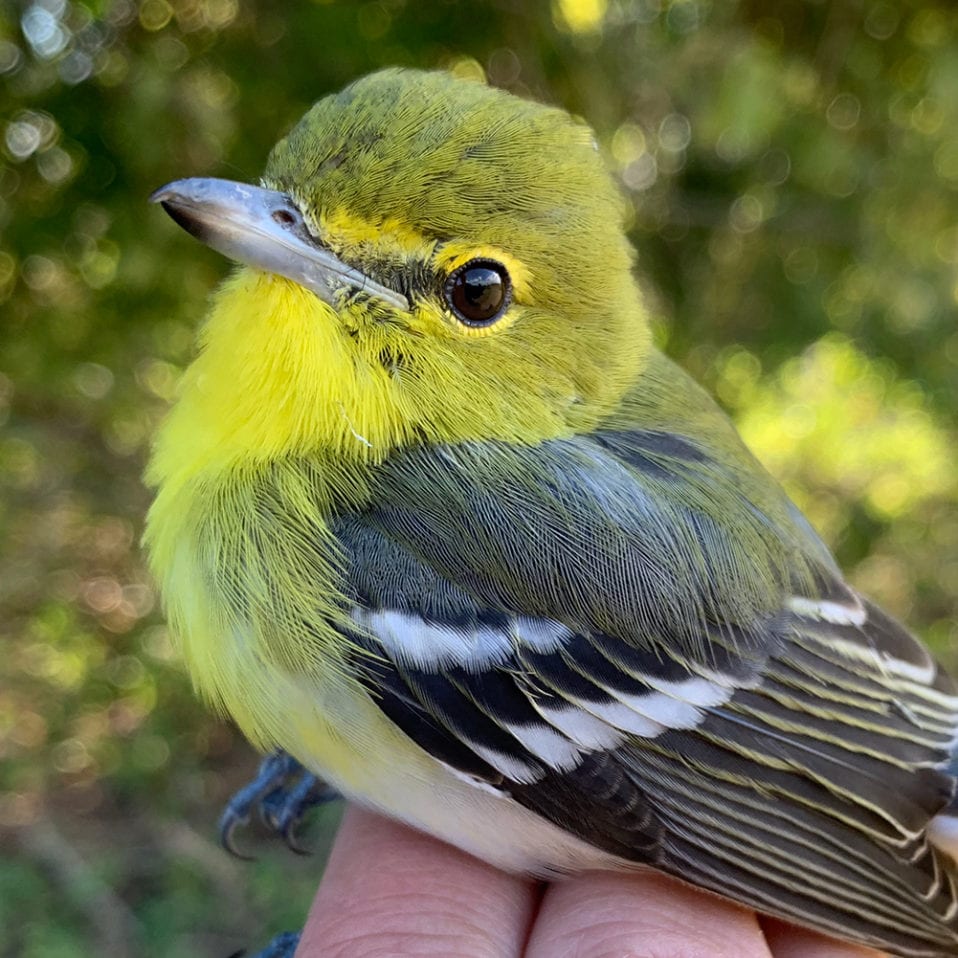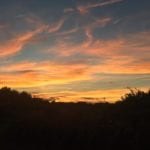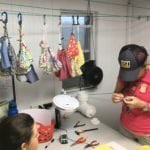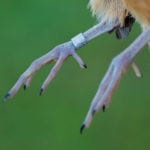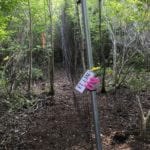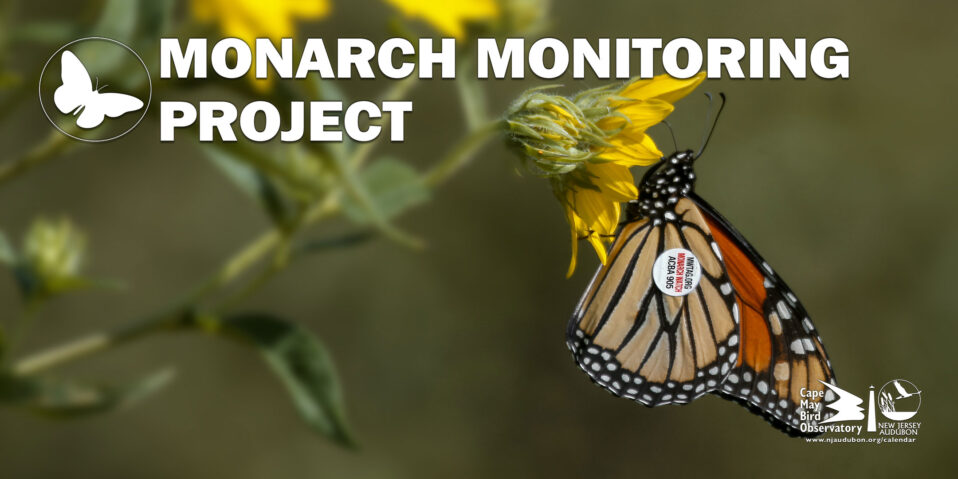Above: Our first-of-the-season Yellow-throated Vireo shows off its almost Day-Glo plumage!
By Laura-Marie Koitsch, 2018 Bander In Charge
One of the main concerns that we faced with opening a coastal banding station in the fall was how to handle Yellow-rumped Warbler migration or, as some of us affectionately dubbed it, “the invasion of the butter-butts.” Yellow-rumped warblers (coded as “MYWA” because we are dealing with the eastern “Myrtle” subspecies) are a social species and, in the fall, they travel in incredibly large flocks that often can be seen in open shrubby areas engorging themselves on berries. We had all heard the stories of how quickly a station’s nets could fill up with these birds and, as bird safety is always our number one priority, we took these warnings and concerns very much to heart.
Although we had already been seeing decent numbers of MYWA at the station for the past week, we had yet to have a big “hit” of them all at once. On October 18th things changed. We opened slightly later than usual that morning due to weather and by the second net round, we had our nets full of birds. We moved quickly into “fallout protocol” which states that we clear and close nets as needed, and reopen as enough birds are processed and conditions allow. However, given the number of birds around the banding area, with the Fall Birding Festival kicking off that afternoon, help was still needed elsewhere & so, we decided not to reopen thus enabling our volunteers to go assist with last minute festival preparations. All in all, it was an incredible morning. We processed 179 birds of 17 species, including our first Yellow-throated Vireo of the season. More importantly, the strength of our team, many of whom had never worked together before now, was tested when we netted 150+ birds in a single net round. Finding that many birds in the nets at one time was also a first for most of the team and yet, everyone worked together seamlessly to make sure birds were processed quickly and safely as if this was something to which we were all accustomed.
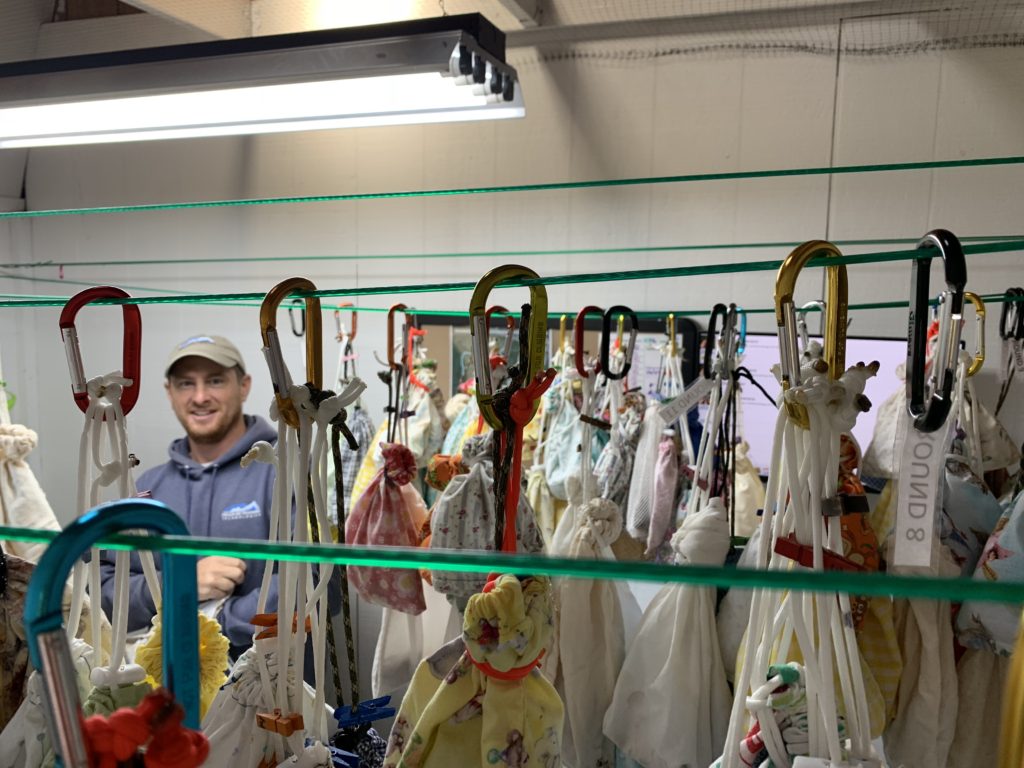
We designed this station knowing that the big days would come, and we would be prepared. Mike smiles as he prepares to band a bird, likely a Yellow-rumped Warbler, as the second bander of the day (Laura-Marie is to his left, out of the frame). © David La Puma
Although we considered the 18th a successful morning, there were still some areas that we could improve, particularly what to do about the number of bird bags that we had on hand limiting how many birds we might be able to process. Our bird bags are lovingly sewn by volunteers and as they are somewhat time-consuming to make, we knew we wouldn’t be able to get more by the next morning. We decided to borrow several bird “hotels” from the NJ Audubon shorebird research team.
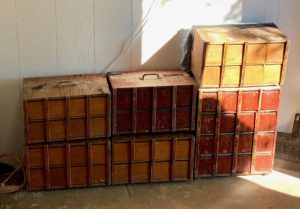
Bird “Hotels” for housing birds waiting to be banded. These custom-built multi-compartmented structures keep birds calm and make the banding process more efficient, while allowing bird bags to be recycled back out into the field on big days.
These hotels are actually wooden boxes with several rows of compartments each of which can safely house two MYWA at the same time, thus freeing up our bags. We picked up the hotels & back-up paper bags just in time as on October 19th we had our biggest day of the season. We processed 667 birds of 30 species. Yes, you read that correctly. We banded 661 new birds, of which 505 were Yellow-rumped Warblers that were processed quickly and efficiently after being housed in their new hotels. It was simply an incredible day! It was also the first day of the Fall Birding Festival so, we had many keen birders stopping by the station interested in learning more about migration here in Cape May.
We also had a film crew stop by the station to talk to NJ Audubon & CTT staff regarding the exciting research projects that we have lined up. The crew (along with Jason Ward, Audubon contributor, social activist, & self-proclaimed “science nerd”) came into the banding station to ask us a few questions & to film some of the banding process. Hopefully the video, which centers around birds and birding in Cape May, will be up on YouTube within the year; of course, we will update everyone via the blog once we know more.

Jason Ward interviews NJ Audubon VP of Research, David Mizrahi, for a 12-part series on Birds of North America. © David La Puma
We also banded our first Orange-crowned Warbler and Lincoln’s Sparrows of the season. If you’ve read our previous weekly roundups, or are simply a gambler at heart, you would have probably guessed that this was our biggest day of the season by far, and you would be correct. Our team worked together admirably, only stopping once to quickly eat some of the delicious local pizza that we had delivered. You may laugh about the pizza break but, our team worked incredibly hard for the first six hours and we needed them to keep working hard for (at least) another four! It almost seems too cliché to be true but, the day did in fact end with a beautiful sunset in the Meadows as the team left to attend a wonderful talk by Dr. Drew Lanham.
There was no banding on October 20th, 21st, or 22nd due to various reasons but, mostly due to wind. Most of the banding team spent their weekend occupied with the birding festival: attending informative talks, volunteering their time, and/or simply out enjoying the spectacle that is fall migration in Cape May. Banding operations resumed on the 23rd and this time with another new addition to our team: Marc Illa, the second young professional we welcomed as part of a multinational bird observatory exchange program. Like Sarah, we suspected that Marc would also prove to be an important and essential part of our banding team in the coming weeks. On the 23rd we processed 279 birds of 23 species. 202 of the newly banded birds were Yellow-rumped Warblers but, we did still get a nice look at three Tennessee Warblers in the hand. We also placed another LifeTag™ on a Carolina Wren for a total of three tagged this season. Or, so we thought. It turns out that our little “James Bond” friend (band ending in 007) that we mentioned in last week’s post had somehow successfully removed his or her first 3D-printed harness and LifeTag™ transmitter and, as we didn’t realize it at the time, we had just outfitted it again with another transmitter. All joking aside, this is incredibly useful data. One of the reasons why we wanted to place this cutting-edge tech on “local” species is because this is the kind of feedback that the designers who have spent years working on this tech want to know; if a bird can get the harness off or if the harness fits improperly it’s better to learn that early on than (for example) after a bird migrates to South America. We’ve got our eyes (and antenna!) on you, 007, and we suspect that we’ll be seeing you again soon.
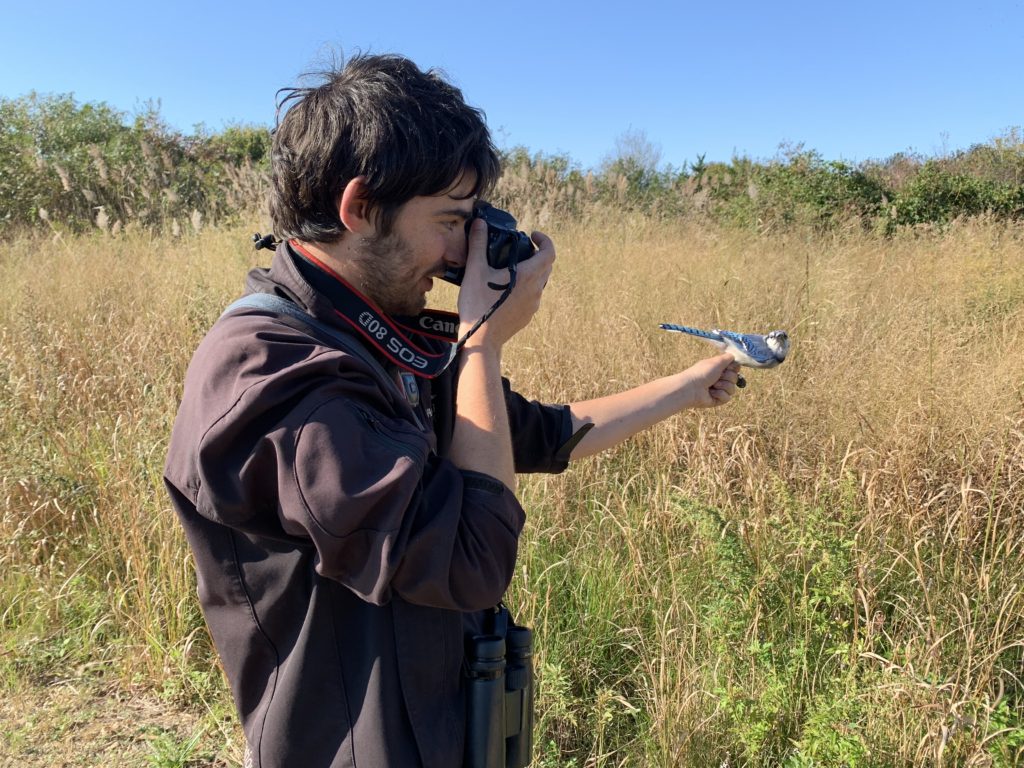
Marc Illa, our Young Professional Exchange participant from Falsterbo Bird Observatory, Sweden, photographs a beautiful Blue Jay after banding. © David La Puma
The morning of the 24th was extremely gusty with winds kicking up to 25mph at opening. With gusts that high, we were extremely cautious about opening any nets and ultimately decided that only six sheltered nets were safe to open. Even though we only operated six nets for a slightly shorter time than usual, we still banded 253 new birds of 14 species. And, yes, most were Yellow-rumped Warblers (213). Highlights included two handsome adult male Purple Finches and two more Sharp-shinned Hawks.
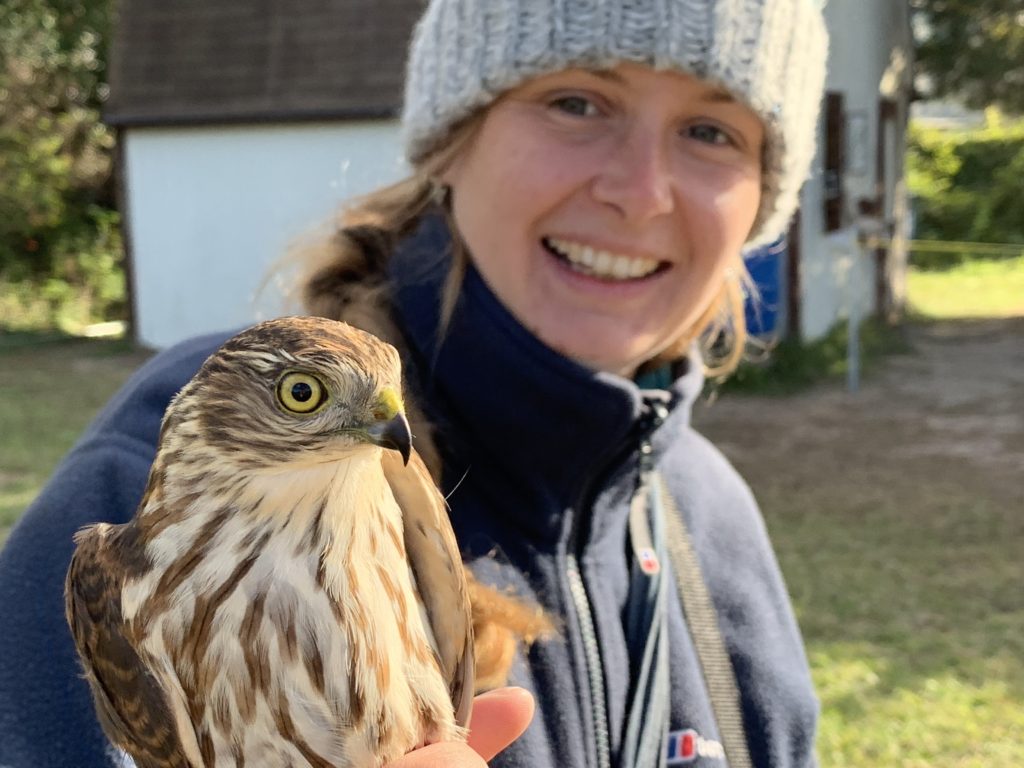
One of our Young Professional Exchange participants, Sarah Harris (Spurn Bird Observatory, UK) with one of our Young Accipiter participants, this Sharp-shinned Hawk. © David La Puma
Week ten of our inaugural banding season saw the biggest capture rates to date. We banded 1,358 new birds across 40 species, including three FOS: Orange-crowned Warbler, Lincoln’s Sparrow, and Yellow-throated Vireo. We operated nets on four out of the past seven days for a total of 262 mist net hours (mnh). Our birds per mnh rate was incredibly high at 5.29. Our top species was (no surprise!) Yellow-rumped Warbler with 1,076 individuals banded. Song Sparrows came in a “close” second (ha!) with 56 individuals banded followed by Swamp Sparrows with 38. We also banded what we imagine will be our last Northern Waterthrush of the year. If any species were to define our inaugural season here it is the Northern Waterthrush and we are all quite sad to see them go (but, excited for their return!).
Over the past week we also recaptured 28 previously banded birds of 7 species. The majority of the recaptures were MYWA and it will be interesting to see if they stick around and are perhaps part of the population that over-winters here or if they are just here for a short period of time, gaining weight before heading further south. We also participated in another incredibly successful CMBO fall birding festival and had an amazing time growing and working together as a team. Since this is our inaugural season, it is perhaps even more important that we work on training long-term volunteers and building our team up than it is that we band all of the birds that pass through the area. Although, of course, banding as many birds as we can safely and efficiently whilst also learning more about their local movements and habitat usage is one of the reasons we’re here. We just can’t forget that building up an incredibly brilliant team is also important this season, the first of the next hundred years!
Week 10 Stats:
| SPECIES | NEW | RECAP | TOTALS |
| Yellow-billed Cuckoo | 2 | 2 | |
| Sharp-shinned Hawk | 4 | 1 | 5 |
| Yellow-Shafted Flicker | 2 | 2 | |
| Eastern Phoebe | 16 | 16 | |
| Yellow-throated Vireo | 1 | 1 | |
| Blue-headed Vireo | 2 | 2 | |
| Red-eyed Vireo | 1 | 1 | |
| Blue Jay | 1 | 1 | |
| Red-breasted Nuthatch | 4 | 4 | |
| Brown Creeper | 3 | 3 | |
| House Wren | 1 | 1 | |
| Winter Wren | 2 | 2 | |
| Carolina Wren | 2 | 2 | 4 |
| Golden-crowned Kinglet | 10 | 10 | |
| Ruby-crowned Kinglet | 12 | 1 | 13 |
| Gray-cheeked Thrush | 2 | 2 | |
| Swainson’s Thrush | 1 | 1 | |
| Hermit Thrush | 5 | 5 | |
| Gray Catbird | 32 | 32 | |
| Purple Finch | 6 | 6 | |
| American Goldfinch | 5 | 5 | |
| Eastern Towhee | 3 | 3 | |
| Chipping Sparrow | 3 | 3 | |
| Field Sparrow | 9 | 9 | |
| Song Sparrow | 56 | 56 | |
| Lincoln’s Sparrow | 2 | 2 | |
| Swamp Sparrow | 38 | 1 | 39 |
| White-throated Sparrow | 12 | 12 | |
| Slate-colored Junco | 1 | 1 | |
| Northern Waterthrush | 1 | 1 | |
| Tennessee Warbler | 3 | 3 | |
| Orange-crowned Warbler | 1 | 1 | |
| Common Yellowthroat | 16 | 1 | 17 |
| American Redstart | 2 | 2 | |
| Magnolia Warbler | 1 | 1 | |
| Blackpoll Warbler | 2 | 2 | |
| Palm Warbler | 15 | 15 | |
| Yellow-rumped (Myrtle) Warbler | 1,076 | 21 | 1,097 |
| Northern Cardinal | 2 | 1 | 3 |
| Indigo Bunting | 1 | 1 | |
| TOTALS | 1,358 | 28 | 1,386 |
Total species this season: 95
Total birds banded this season: 5,301




